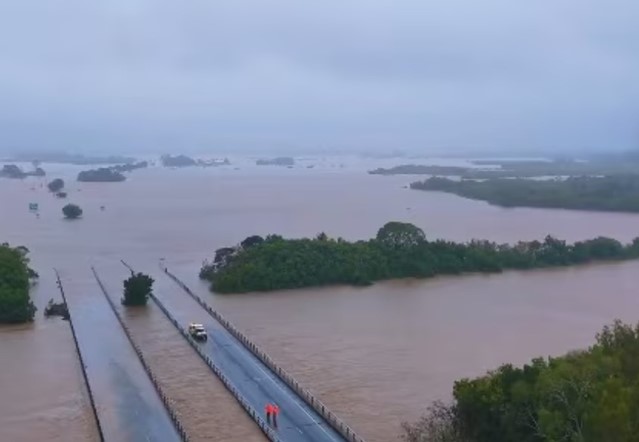
Insurance Premiums Hit Record Highs as Floods and Storms Intensify
Katy Williams, a mother from Charleville in south-west Queensland, finds herself in a tough spot after receiving an insurance quote she can't afford. Despite having three school-aged boys, she knows she can't risk being uninsured.
"This house holds everything I own," Ms. Williams said.
However, to keep her flood insurance, she's been told her annual premium will skyrocket from just over $5,000 to more than $15,000.
"As a single mother, $15,000 is just not feasible. I'm starting to wonder if insurance is even worth it," she remarked.
A Surge in Claims and Rising Costs
Ms. Williams is not alone in facing rising insurance costs. Many Australians are struggling to either pay increasing premiums, search for cheaper options, or go without coverage altogether.
The Insurance Council of Australia (ICA) recently released its Catastrophe Resilience Report, highlighting that floods have become the most significant driver of insurance claims among all extreme weather events in the country. The report revealed that over 150,000 claims were made in 2023–24, marking an almost 75% increase compared to the previous period.
Over the past five years, the average annual cost to insurers from flood damage has risen to $2 billion, a sharp increase from the $620 million average recorded over the previous 30 years.
"Flooding is Australia's most expensive natural hazard," said ICA Chief Executive Andrew Hall. "It's estimated that around 1.2 million properties are at some level of flood risk."
These rising costs are being passed down to consumers. Insurance prices rose by 14% to reach record highs in the 12 months leading up to June 30, according to data from the Australian Bureau of Statistics.
Hall pointed out that while higher building costs and reinsurance (insurance for insurance companies) have driven up premiums, the most significant factor has been the increasing severity of weather events. "These are the three main drivers behind the upward pressure on insurance premiums, not just in Australia, but globally," he added.
Extreme Weather's Impact on Insurance
Recent years have seen extreme weather events causing widespread damage across Australia. Nearly 100,000 insurance claims were filed following severe storms during last year's Christmas period, impacting the Gold Coast, parts of New South Wales, and Victoria, costing insurers around $1.3 billion.
In the same month, Tropical Cyclone Jasper and subsequent flooding in Far North Queensland damaged 1,863 properties, resulting in more than $350 million in claims paid by June 30, according to the ICA.
Earlier in 2023, widespread floods hit the Gulf of Carpentaria and New South Wales' south coast, while bushfires damaged properties in Western Australia and southern Queensland. The 2022 floods in south-east Queensland and northern New South Wales became the largest insurance loss event in Australian history, with 250,000 claims costing insurers an estimated $6 billion, according to the ICA.
Should Postcodes Determine Premiums?
The impact of climate change on insurance premiums has become a focus of a Senate select committee currently investigating the issue across the country. Hearings have been held in Brisbane and Ballina, with another scheduled in Sydney in September. While submissions are now closed, various stakeholders, including insurance companies, environmental groups, individuals, and councils, have contributed their perspectives.
The flood-prone town of Charleville, where Ms. Williams resides, has also made a submission. The town's mayor has urged insurers to consider flood mitigation efforts when determining premiums, rather than relying solely on postcode-based assessments.
"Instead of basing premiums on postcodes and past events, we'd like to see insurers recognize the flood mitigation measures in place," said Murweh Mayor Shaun Radnedge.
Charleville, a town of nearly 3,000 people on the Warrego River, has experienced several severe floods in recent decades. A flood levee was constructed around Charleville in 2011 to protect homes from future floods, and since then, no homes within the levee have been flooded, according to the council.
Before the levee was built, the town faced a different reality. In 1990, more than 1,000 homes were submerged, and the entire town was evacuated after the Warrego River peaked at over 8.5 meters. In 2010, a flood exceeding 6.5 meters inundated more than 400 properties, including Ms. Williams' home.
Some insurance companies determine premiums based on postcode-level assessments, rather than evaluating the risk of individual properties. Hall noted that this approach can make insurance more expensive for some, but it can also lower costs for properties in higher-risk areas.
"Often, the less expensive properties are the ones most affected, making higher premiums harder to afford for those living there," he said.
A Tough Decision
Ms. Williams mentioned that the flood 14 years ago was the only time she filed a claim on her home insurance, and she was grateful for the coverage when repair costs exceeded $120,000. However, facing a $15,000 premium, she's now considering whether to drop flood coverage from her insurance policy for the upcoming year.